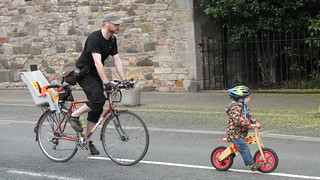Oh dear Just watched that piece and Chris O did look a bit 'cardboard' probably not helped by being in a remote 'studio' (box room with a camera), that contrasted with the opposite extreme of animated and aggressive response from someone used to being on air.
Immediate response - Glasgow-wise would be yes we are slowly getting some important links restored mst notably the compromise of reconnecting a historic route which until the 1970's was a vibrant highway* with shops and commercial activity bustling with people travelling -often on foot and from the late 1800's by bike between Partick and Glasgow. After over 40 years when this route was cut through by the M8 - turning some areas of the city into a wasteland we are at last, not by a clear and positive government policy , but funding 'won' after having made a strongly contested bid for lottery fund money, and a determined effort to find the matching money from all available sources, getting the route reconnected - but still in a compromised way.
(* The Great Dumbarton Highway appears as an established route on the maps of Thomas Kyle, and is referenced on property deeds back into the 1700's as the route which owners had rights to access across neighbouring lands In Glasgow it IS Argyle Street which can still be traced through despite all the efforts to rub it out in Anderston)
Other examples show that it is not by government 'pull' but the 'push' of the public at large wanting to get around on foot and by bike that so often has to be the driver for any development.
I'm not a great fan of segregated facilities, especially where they exist in isolated pockets creating the conflict of movement at every point they intersect with general purpose roads, or a footway becomes a 'carriageway' for cycling, so often showing a lack of any design features to integrate the various flows of traffic - pedestrian, cycle, and motorised and positively creating the conditions for collisions and near collisions to occur.
The 'Bridge to Nowhere' is closing that gap, with the cycling routes to link in to it peppered with compromise, and convoluted connections, such that for a cyclist making progress and wanting to travel at moderate speed, it is simply safer and faster to use the road. Even in the detailing it shows a lack of the ability to use standards that are actually specified for cycle routes - all the tramline paving used fails to meet the DfT standard specified after extensive testing to mitigate the risk of the raised ridges bringing down a cyclist.
To the North of that Bridge to Nowhere the vitality that was Argyle Street can be visualised from the shops and businesses along Woodlands Road, which escaped severance (just) and where the determined passage of pedestrians walking across the car biased junctions of St Georges Road, Newton St, Sauchie, and Woodlands with the M8 slip roads, actually forced the roads authorities to shoe-horn in a footway at street level - but still take 40 years to properly set this out to deliver safe pedestrian movement across the road junctions, further North pedestrians still walk along the central reservation of the rump of a connection between West Graham Street and Great Western Road, so appallingly dire are the routes offered to those not on wheels.
As for that comment on the A9 cycle route - clearly until it is delivered with a surface quality and alignments equivalent or comparable with the road many cyclists will use the road - after all for most of us around a quarter of the local taxes we pay, and likewaise a substantial portion of our national taxation goes towards Roads and Transport, so we expect to be able to use what we are paying for.
And as for Keith Brown's piece - was that archive material? When I last walked down to the bottom of the hill on Glasgow I saw a motorway which, when I join it in a car takes me on roads which appear pretty much to be motorways all the way to Carlisle, Perth, Edinburgh, and well on the way to Aberdeen and Inverness. I would seriously question the value of spending vast amounts on extending these roads further given the paucity of traffic using them outside some very short peak periods, suggesting that the answer to the cries of 'lack of capacity should be rebutted by a call to "Use what you've got more efficiently" When I drive I can often get between key points without seeing a single vehicle travelling in my direction - on some routes (like the A68) even in daylight hours. Billions of pounds just to give me an empty carriageway - Thank you, but it might be nice to have a route for cycling.

 posts
posts
